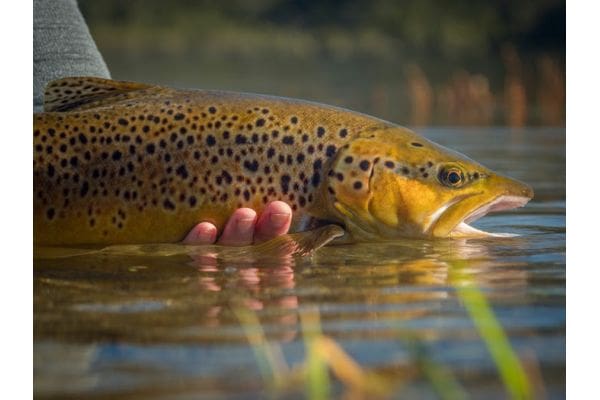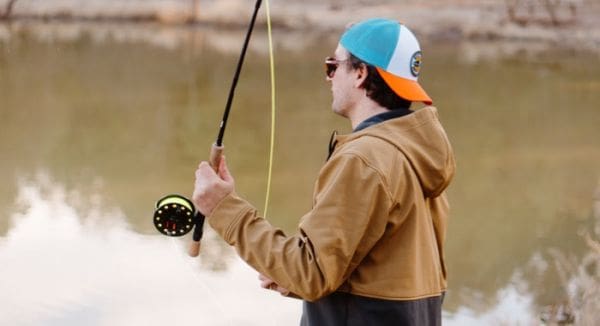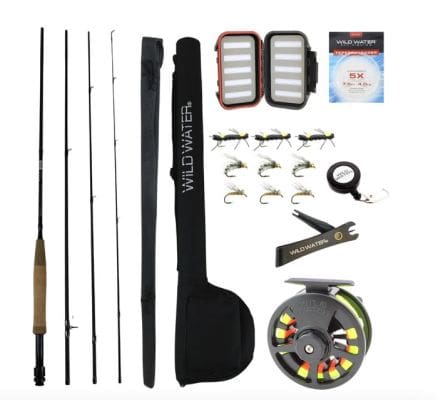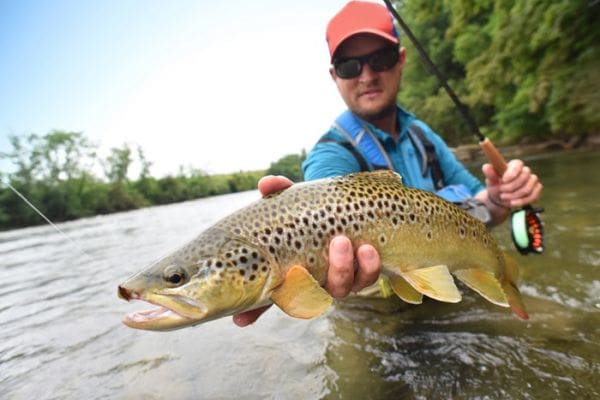TIPS FOR FLY FISHING DIRTY & MUDDY WATER

In a perfect world, every day would have ideal conditions for fishing. But when water is fast-moving, dirty, or muddy, it can be challenging for even the most seasoned fly fishermen.
Still, that’s one of the beautiful things about fly fishing: Every day is unique and presents different challenges, so how can you tackle dirty or muddy water head-on and still have a successful day on the water?
Wild Water Fly Fishing is here to hash out the tried and tested tips for fly fishing in dirty and muddy water ‒ so you’re always prepared and ready for the challenge! We’ll also cover the difference between dirty vs. muddy water, the best techniques, and which supplies and fishing gear will optimize your day when the water conditions are less than ideal.
THE DIFFERENCE BETWEEN DIRTY VS. MUDDY WATER
Believe it or not: There is a difference between dirty and muddy water ‒ and each condition presents challenges.
Pretend you have a 12-inch ruler that you insert vertically into shallow water. (You can also do this the next time you’re fly fishing and aren’t sure if the water is dirty or muddy.)
Let’s say you can only see the ruler for half its length; the water is substantially muddy. Even if most of the ruler can be seen, the water is still dirty. With that said, anytime large quantities of debris and sediment push downstream, causing dirty or even muddy water, it can change the way you’ll fly fish if you want to experience quality catches.
HOW DIRTY & MUDDY WATER AFFECTS FLY FISHING
If water visibility is low, chances are the water level is also high and fast-moving. These conditions create what is known as high water or a blown-out river or stream.
In these conditions, fish have difficulty deciphering what’s food ‒ and what’s a threat, so they’re likely to veer towards the edges of a stream, along the banks, or side channels, where water is softer than the midstream currents. Fish will also stick close to the bottom, where the water is slower, which helps them not work as hard to maintain their position against such torrential flows.
In high, muddy water, you can also target fish in the river eddies or the sections of the river that move upstream and swirl in a reverse current.
TIPS FOR FLY FISHING IN DIRTY & MUDDY WATER
Don’t let dirty or muddy water deter you from enjoying what you love. When up against dirty or muddy water, you have to change your technique ‒ and by following these tips for fly fishing in adverse conditions, you can still have some quality outings.
CHOOSE A HEAVY TIPPET & LEADER
When fly fishing in dirty or high, muddy water, having extra weight on your line can help you target the fish lurking along the bottom of the river banks and side channels by keeping your flies slowly ticking along in their lane. Add extra weight to your leader and choose a heavier tippet. In these conditions, fish aren’t nearly as line shy.
Tippets and leaders come in a variety of diameters. When visibility is low and water levels are high, use a tippet and leader of at least 3X or more. You can add a split shot a couple of inches above your fly to get down faster. By increasing the strength of your tippet and leader, you’ll have an easier time catching fish in dirty, fast-moving water. But keep in mind that the heavier the leader, the slower it will sink toward the bottom ‒ so be patient.
When encountering these tough conditions, it’s essential to use a heavier rod. The Wild Water Deluxe 5/6 Fly Fishing Kit with a heavier tippet or leader described above should suffice.
Bigger and bulkier flies are almost always more effective at attracting fish in low-visibility conditions. The faster the water, the heavier the fly should be to help produce the most vibration through the turbid currents. But there’s more that goes into personalizing your lure on a day when conditions are dirty or muddy. We’ll explore that next.
STRATEGIZE YOUR FLY
The dirtier the water, the flashier you’ll want your flies to be. Stay away from brown or natural green hues, as these can resemble the color of dirty or muddy water. Black and red are the best colors because they accentuate the silhouette of the fly, making it more noticeable to fish.
Streamers and nymphs can also come in handy. Nymphs or streamers that are patterned and have vibrant colors should be enough to catch the fish’s attention.
A streamer can be more effective if you’re going to fish at a greater distance. Because visibility is slightly better in dirty water than muddy water, you don’t necessarily need to use the flashiest streamers or nymphs. As long as you avoid the fast-moving currents in the middle of the river or stream and stick closer to the side channels, a patterned or colored lure should suffice.
Noisy flies can also attract fish in high, muddy waters. Tying in a few clicking or rattling brass beads, or mylar tubing, to your line can add noise to your flies.
CAST HALF YOUR NORMAL DISTANCE
When visibility is low, you should cast half the distance you usually would. Make shorter drifts and cast only a few inches further out. Because the fish will be closer to the banks, there’s less of a need for you to wade. Fish can only see a few inches in front of them in muddy conditions.
Using streamers, you’ll want to move slightly faster than with nymphs. You’ll need to give fish more time to spot your fly when the visibility is low or when the fish are seeking refuge at the bottom of a riverbank.
DON’T LET DIRTY OR MUDDY WATER DETER YOU FROM FLY FISHING
As a fly fisherman, you’ll encounter dirty and muddy water at some point ‒ but you shouldn’t let it turn you away. By following these tips for fly fishing in these challenging conditions, you can still have a successful and memorable day on the water.
For more information regarding Wild Water Fly Fishing and their products, please contact Dena Vick, dena@kingeiderpr.com.
About Wild Water Fly Fishing
Wild Water Fly Fishing represents a dedication to bringing friends and family together by providing everything you’ll need to gear up for a trip to the lake. If you’re a parent or grandparent wanting to nurture a kid’s interest in fly fishing, Wild Water provides the best tools to make your fly fishing trip an unforgettable experience. Wild Water Fly Fishing is the only company to focus exclusively on affordable, easy-to-use fly fishing starter packages for all species of fish.




